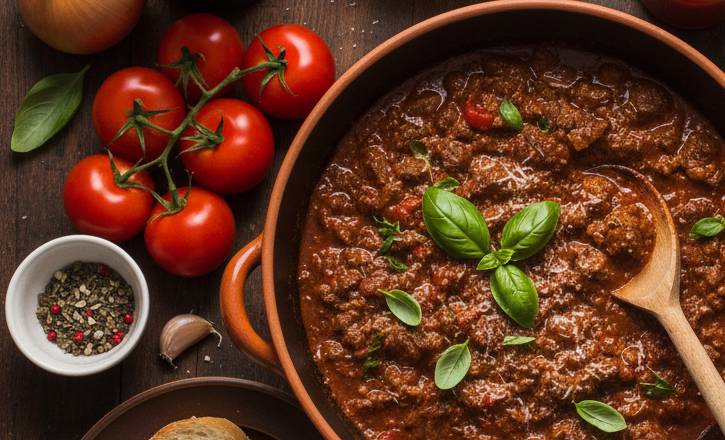
Ragu isn’t just a sauce; it’s a culinary masterpiece, a celebration of time and patience that results in a deeply rich and flavorful meat sauce. Unlike a quick marinara, a classic ragu is slowly simmered for hours, allowing the flavors of the meat, wine, and vegetables to meld into a complex and unforgettable sauce. This guide will show you how to build a ragu from the ground up, proving that a little time can create a dish that’s truly timeless.
The Ingredients: Building a Rich Foundation
The key to a classic ragu is a combination of different meats and a well-prepared aromatic base.
- 1/2 lb ground beef (80/20 ratio for flavor)
- 1/2 lb ground pork
- 1/2 lb ground veal (optional but recommended for tenderness)
- 2 tbsp olive oil
- 1 large onion, finely diced
- 2 carrots, finely diced
- 2 celery stalks, finely diced
- 4 cloves garlic, minced
- 1 cup dry red wine (like Merlot or Cabernet Sauvignon)
- 1 (28 oz) can whole peeled tomatoes, crushed by hand
- 1 cup beef broth
- 2 tbsp tomato paste
- 1 bay leaf
- Salt and black pepper to taste
Step 1: Brown the Meat
Heat the olive oil in a large Dutch oven or heavy-bottomed pot over medium-high heat. Add the ground meats and cook, breaking them up with a spoon, until they are browned all over. Season with salt and pepper. Drain any excess fat, leaving just enough to cook the vegetables.
Step 2: Sauté the Aromatics
Add the diced onion, carrots, and celery to the pot. Cook over medium heat for about 8-10 minutes, stirring occasionally, until the vegetables are soft and the onion is translucent. This is called a soffritto, the flavor base for the sauce. Add the minced garlic and cook for another minute until fragrant.
The Simmer: Where the Magic Happens
Step 3: Deglaze with Wine
Pour the red wine into the pot, scraping up any brown bits from the bottom. Let the wine simmer for a few minutes until it has reduced by about half.
Step 4: Combine the Sauce
Stir in the tomato paste, mixing it well with the vegetables and meat. Add the crushed tomatoes, beef broth, and bay leaf. Stir everything to combine, making sure the sauce is smooth.
Step 5: Slow Simmer
Bring the sauce to a gentle simmer, then reduce the heat to low. Cover the pot and let the ragu cook for at least 2 to 3 hours, or even longer. The longer it simmers, the more the flavors will deepen. Stir occasionally to prevent sticking. The sauce is ready when the meat is incredibly tender and the sauce is thick and rich.
Step 6: Finishing Touches
Remove the bay leaf. Taste the ragu and adjust the seasoning with salt and pepper as needed.
Conclusion
A classic ragu is a culinary journey that rewards patience with an incredibly complex and flavorful sauce. The slow simmering process tenderizes the meat and allows the sweet, savory, and aromatic flavors to meld into a harmonious whole. This isn’t just a sauce for pasta; it’s a testament to the power of traditional cooking. Serve it with a wide, flat pasta like pappardelle or tagliatelle to properly hold all the deliciousness.
FAQ
Q: Can I use just one type of ground meat?
A: You can, but a blend of beef, pork, and veal creates the most complex and balanced flavor. Beef provides a strong, rich taste, pork adds fat for juiciness, and veal contributes tenderness.
Q: What if I don’t want to use wine?
A: The wine adds a crucial layer of flavor. You can substitute it with more beef broth or a combination of broth and a splash of balsamic vinegar to add a little acidity.
Q: What is the best kind of tomato to use?
A: Canned whole peeled tomatoes are highly recommended. They have a richer, more concentrated flavor than diced or pureed tomatoes. Crushing them by hand gives you more control over the sauce’s texture.
Q: How do I know when the ragu is done?
A: The ragu is done when the sauce is thick and rich, and the meat is incredibly tender and has almost disintegrated into the sauce. The flavors will be deep and well-blended, not tasting like individual ingredients.
Q: Can I freeze this ragu?
A: Yes, ragu freezes beautifully. Let the sauce cool completely, then transfer it to an airtight container or a freezer bag. It can be frozen for up to 3 months. Reheat it gently on the stove or in a microwave.